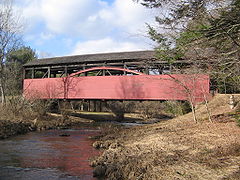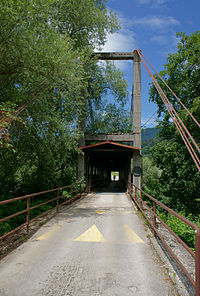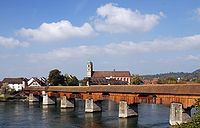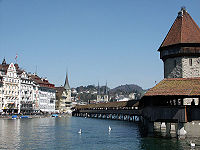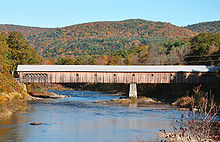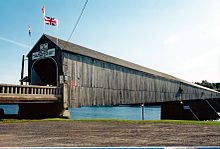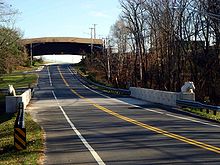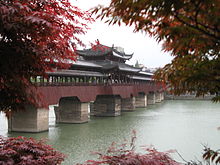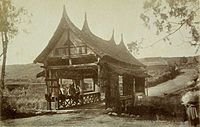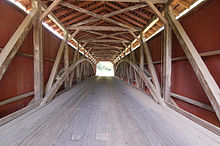- Covered bridge
-
Covered Bridge
The Cogan House Covered Bridge over Larrys Creek, Cogan House Township, Pennsylvania, U.S.Ancestor Truss bridge, others Related Tubular bridge, Skyway, Jetway Descendant None Carries Pedestrians, livestock, vehicles Span range Short Material Typically wood beams with iron fittings and iron rods in tension Movable No Design effort Low Falsework required Determined by enclosed bridge structure, site conditions, and degree of prefabrication A covered bridge is a bridge with enclosed sides and a roof, often accommodating only a single lane of traffic. Most covered bridges are wooden; some newer ones are concrete or metal with glass sides. Mainly associated with the 19th century, covered bridges often serve as prominent local landmarks and have long attracted the attention of historic preservationists.
The enclosure acts as weather protection over the working part of the structure. For example, a bridge built entirely out of wood, without any protective coating, may last 10 to 15 years. Builders discovered that if the bridge's underpinnings were protected with a roof, the bridge could stand for 70 or even 80 years. Existing covered bridges have been renovated using concrete footings and steel trusses to hold additional weight and to replace the original support timbers. Some covered bridges, such as the ones in Newton Falls, Ohio and Elizabethton, Tennessee, also feature an integrated covered walkway.
Contents
Construction
Early bridges were often made of wood, especially where it was a plentiful resource. Wooden bridges tended to deteriorate rapidly from exposure to the elements, having a useful lifespan of only nine years. Covering them protected their structural members, thus extending their life to 80 years or more.
Most wooden covered bridges employ trusses as their key structural design element. A popular design was the Brown truss, known for its simplicity; but others were also used.
Given the ready availability of steel, concrete, and other modern construction materials, most modern covered bridges are built either for the convenience of the user, rather than to protect the structure itself, or as a statement of style or design.
Many of the oldest bridges were built as post-and-pile construction. This is commonly seen in stone construction, where columns (piles) are used to support spans (posts) covering open spaces. The Kapellbrücke in Lucerne is an example. A modern example is the Covered Bridge, Lovech, which uses stone piers and steel beams. Many older bridges were built using an arch. The Ponte Coperto in Italy and the Ponte Vecchio in Florence, Italy, are examples. As bridge needs increased in North America, designs turned to available material, wood. In order to cover the spans needed, truss design was extended and improved. Eleven major trusses were used during the period of wood construction.
Standard Truss Types The earliest covered bridges used the simple King post and Queen post design. These had been traditional truss types for building construction. Older bridges along the east coast are often dominated by King and Queen post designs. Beginning around 1820, new designs were being developed.
- King Post, most of the remaining covered bridges in Virginia are either King post or Queen post designs. See: List of Virginia covered bridges
- Curved Multiple Kings Post, an example adopted by local conditions is the Humpback Covered Bridge in Virginia. It is a curved truss using the King post design.
- Queen post, most Queen posts are in New England, with a few on the west coast. It is also a common design used for non-covered steel bridges.[1]
New truss designs allowed for longer crossings and heavier loads. The Long truss is common through Alabama.
- Long, 1830 Most long truss bridges are in Ohio, New York, and New Hampshire. Others can be found elsewhere in the United States.[2]
- Lattice Truss (Town’s lattice), 1820 and 1835. Ashtabula County, Ohio has several lattice truss bridges remaining. The longest Town lattice and before 2006, the longest wooden covered bridge is the Cornish–Windsor Covered Bridge in New Hampshire, spanning the Connecticut River. It is 449 feet (137 m) long. Vermont has a large number of lattice bridges still standing. See: List of Ashtabula County covered bridges and List of bridges on the National Register of Historic Places in Vermont
- Burr Arch Truss, 1840. Parke County, Indiana has the largest concentration of covered bridges, 35, in the United States. Lancaster County, Pennsylvania has 29 covered bridges, the most in a Pennsylvania County. The majority of both counties covered bridges are Burr arch designs. See: Parke County Covered Bridges and List of covered bridges in Lancaster County, Pennsylvania
- Howe, 1840 The Howe truss is most common in the west and far west. It is found through Ohio, Indiana, Missouri, and California.[3]
- Brown, 1857. The only remaining examples appear to be located in Kent and Ionia Counties, Michigan. They include the Ada Covered Bridge, the Fallasburg Bridge, and Whites Bridge [4]
- Partridge truss is a common design in Ohio, such as in the Bergstresser Covered Bridge[5]
- Childs truss, about 1860’s. All known examples are located in Ohio. See: List of Ohio covered bridges [6]
- Post, mid-19th century. The Post truss design in nearly gone. Only two known iron variants survive, one covered combination truss variant, the Bell Ford Bridge has been dismantled and is in storage awaiting rebuilding.[7]
- Smith Type IV Truss predominate in Ohio and Indiana. Western Pennsylvania and northern Kentucky each have one and two, respectively.[8] See: Cataract Falls Covered Bridge, Indiana; Byer Covered Bridge, Ohio; Wheeling Covered Bridge, Indiana
- The McCallum Truss. The only remaining bridge in the world using this truss is the Percy Covered Bridge at Powerscourt, Quebec, Canada. The McCallum inflexible arched truss was designed by Daniel McCallum for railways in North America. With the advent of steel construction, all of these wooden railroad bridges were eventually torn down, except the Percy Bridge, built in 1861. It is the oldest covered bridge in Canada.[9]
Truss types commonly mentioned today, are primarily steel bridges. This includes the Pratt, Parker, Pennsylvania, and Baltimore.
Covered bridges in Europe
The Western tradition of covered bridges originated in Europe.
Surviving or reconstructed European covered bridges include:
- Ponte Coperto over the river Ticino, Pavia, Italy, built 1354 (picture)
- Bridge over the river Rhine from Bad Säckingen, Germany, to Stein, Switzerland (picture), first built before 1272, destroyed and re-built many times.
- Bridge over the river Muota, Brunnen, near Lake Lucerne, Switzerland (picture)
- Bridge over the river Saane/Sarine, near Fribourg, Switzerland (picture)
- Kapellbrücke, in Lucerne, Switzerland — 204-metre (669 ft) long, originally built 1333; destroyed by fire 1993 and rebuilt
- Irgandı, in Osmangazi, Turkey 1367
- The Covered Bridge in Lovech, Bulgaria — built 1874
- Logic Lane covered bridge in Oxford, England — built 1904
- Pont de Rohan over The River Elorn in Landerneau, Brittany, France. built 16th 17th century.
Famous stone covered bridges include the Rialto Bridge in Venice, Italy which for long was one of only three over the Grand Canal and a popular tourist attraction.
The Bridges of Sighs in Venice, Cambridge and Oxford are also covered bridges.
Covered bridges in North America
Such bridges are found in rural areas throughout the United States and Canada, but are often threatened by arsonists, vandals, and flooding. In the United States, Pennsylvania has more covered bridges (over 200) than any other state, many of which can be seen in Bedford, Somerset, Washington, Chester and Lancaster Counties. The U.S. states of Vermont and New Hampshire have more covered bridges per square mile than any other place in the world. Oregon has the largest number of historical covered bridges in the western United States.[10] They are also common in places such as Elizabethton, Tennessee; Lane County, Oregon; Madison County, Iowa; Parke County, Indiana; and Blount County, Alabama. Parts of California, Indiana, Ohio, Michigan, Kentucky, Maryland, Minnesota, Virginia, West Virginia, Wisconsin, and the New England states have surviving covered bridges.
There are various structural designs used for covered bridges, such as the Burr Truss.
Opened on July 4, 1901, the 1,282-foot (391 m) Hartland Bridge, crossing the Saint John River at Hartland, New Brunswick, is the longest covered bridge in the world. It is a national historic site. In 1900, New Brunswick had an estimated 400 covered bridges, and Quebec more than 1,000, while Ontario had only five. As of 2006[update], there were 94 covered bridges still standing in Quebec,[11] 65 in New Brunswick, and one in Ontario, the West Montrose Covered Bridge.[12]
A much longer covered bridge (5,960 feet / 1,820 metres) between Columbia and Wrightsville, Pennsylvania once spanned the mile-wide Susquehanna River, making it the longest and most versatile covered bridge in the world during its existence. It featured railroad tracks, a towpath for canal boats crossing the river between two canals on either bank, and a carriage/wagon/pedestrian road. The popular toll bridge was burned June 28, 1863, by Union militia during the American Civil War to prevent its usage by the Confederate Army of Northern Virginia during the Gettysburg Campaign. A replacement wooden covered bridge was destroyed by a windstorm a few years later. It was rebuilt as an open-air steel bridge.
Currently, the longest existing covered bridge in the United States is the Smolen-Gulf Bridge (613 feet / 187 metres) spanning the Ashtabula River near Ashtabula, Ohio, which was completed in 2008. Prior to its completion, the Cornish-Windsor Covered Bridge (449 feet / 137 metres) connecting Cornish, New Hampshire and Windsor, Vermont built in 1866, was the longest. The shortest is the West Liberty Covered Bridge (18 feet / 5.5 metres) in Geneva, Ohio.
The town of Blenheim, New York had the longest single-span covered bridge in the world (232 feet / 71 metres). Built in 1855, it was later destroyed on August 29th, 2011 due to flooding from Hurricane Irene. It was one of only six "double-barreled" covered bridges in North America; that is, a bridge with two traffic lanes separated by a supporting truss. There are other double-barreled bridges in Vermont (2), Ohio (1), Indiana (1), and West Virginia (1).
Covered bridges are generally considered old-fashioned and appeal to tourists.
Covered bridges in Asia
In Asia, covered bridges are most prevalent in China, where they are called lángqiáo (廊桥). There are many covered bridges, called "wind and rain bridges" in the Chinese province of Guizhou. These were traditionally built by the Dong minority people. There are also many covered bridges in the Fujian province of southern China.[13]
Taishun County, in southern Zhejiang province near the border of Fujian, has more than 900 covered bridges, many of them hundreds of years old, as well as a covered bridge museum.[14][15] There are also a number in nearby Qingyuan County, as well as in Shouning County, in northern Fujian province. The Xijin Bridge in Zhejiang is one of the largest.
There is a well known covered bridge in Hoi An, Vietnam (in the Quang Nam Province of Vietnam's South Central Coast), called Chùa Cầu—the Japanese Bridge.
Modern covered bridges
Modern covered bridges are usually for pedestrians, for example to walk from one part of an office building to another part, to cross railway tracks at a station, or in a shopping center on an elevated level, crossing a road. See also skyway.
Glass-walled covered bridges are rather common at American airports, and some of those bridges can be found at John F. Kennedy Airport in New York City.
Also, some highway bridges, such as the George Washington Bridge, have lower decks for additional capacity, and those decks, while generally open on the sides, can be enclosed with plastic from time to time during construction, thus rendering the lower decks as partially covered bridges.
The Bloor-Danforth subway in Toronto, Ontario, crosses the Rosedale Ravine on a covered bridge made of concrete.[16]
Covered bridges in fiction
North American covered bridges received much recognition as a result of the success of the novel, The Bridges of Madison County written by Robert James Waller and made into a Hollywood motion picture starring Meryl Streep and Clint Eastwood. The Roseman covered bridge from 1883 in Iowa became famous when it was featured in both the novel and the film.
See also
- Lists of extant historic covered bridges by U.S. state
- List of Alabama covered bridges, 11 bridges
- List of Indiana covered bridges, 98 bridges
- Parke County Covered Bridges, 32 bridges
- Iowa covered bridges
- List of Madison County Covered Bridges, 6 bridges
- List of Michigan covered bridges, 9 bridges
- List of Missouri covered bridges, 4 bridges
- List of New Hampshire covered bridges, 54 bridges
- List of New York covered bridges, 29 bridges
- List of Ohio covered bridges, 125 bridges
- List of Ashtabula County covered bridges, Ohio; 17 bridges
- List of Oregon covered bridges, 51 bridges
- Pennsylvania covered bridges
- List of bridges on the National Register of Historic Places in Pennsylvania
- Covered Bridges of Bradford, Sullivan and Lycoming Counties, Pennsylvania; 7 bridges
- List of Lancaster County covered bridges, Pennsylvania; 29 bridges
- List of covered bridges in Vermont, 106 bridges
- List of Virginia covered bridges, 8 bridges
- List of West Virginia covered bridges, 17 bridges
References
- ^ Bridge Hunter, Queen post truss listing
- ^ Bridge Hunter, long truss listing
- ^ Bridge Hunter, Howe truss listing
- ^ Bridge Hunter, Brown truss
- ^ Bridge Hunter, Partridge truss
- ^ Bridge Hunter, Childs truss
- ^ Bridge Hunter, Post truss listing
- ^ Bridge Hunter, Smith truss listing
- ^ McCallum Truss.
- ^ Covered Bridge Society of Oregon
- ^ Travis, Dale (Jan 31, 2009). "Quebec Covered Bridges List". http://www.dalejtravis.com/cblist/cbqc.htm. Retrieved 2009-10-31.
- ^ "West Montrose Covered Bridge". Visiting the Region of Waterloo. http://region.waterloo.on.ca/web/region.nsf/vwSiteMap/4F08D9C14E31E3A085256B090055CF08?OpenDocument. Retrieved 2009-10-31. "The West Montrose bridge is the last covered bridge in Ontario."
- ^ Fujian Bridges!
- ^ Museum of Ancient Bridges, Taishun County
- ^ langqiao.net (Chinese)
- ^ A History of Subways on Bloor and Queen Streets
External links
- Pierce, Phillip C.; Brungraber, Robert L.; Lichtenstein, Abba; Sabol, Scott; Morrell, J.J.; Lebow, S.T. (April 2005). "Covered Bridge Manual: Publication No. FHWA-HRT-04-098". US Department of Transportation, Federal Highway Administration, Turner-Fairbank Highway Research Center. http://www.tfhrc.gov/structur/pubs/04098/. Retrieved 2008-10-22.
- "The Covered Bridges of Ohio: A Photo Guide"
- List of covered bridges in North America
- "10 great places to cross that covered bridge." USA Today. September 9, 2004.
- Covered Bridges Recorded by Historic American Buildings Survey (HABS) and the Historic American Engineering Record (HAER)
- Covered Bridges of Parke County, Indiana. "Covered Bridge Capital of the World"
- North Carolina Covered Bridges.
- The Ashtabula County (Ohio) Covered Bridge Festival
- Olin's Covered Bridge Museum, Ashtabula, Ohio
- Oregon covered bridges
- Oregon covered bridges supplemental PDF
- Historic Covered Bridges of Pennsylvania.
- Bedford County Pennsylvania Covered Bridges
- "Pennsylvania Dutch" covered bridges.
- Covered Bridges in Tennessee. Tennessee Department of Transportation.
- Existing Covered Bridges in Tennessee.Tennessee Department of Transportation.
- Existing Covered Bridges in Tennessee: Elizabethton Covered Bridge. Tennessee Department of Transportation.
- Doe River Covered Bridge at Elizabethton, Tennessee
- Vermont covered bridges. VirtualVermont.com
- Covered bridge driving tours and pictorial essays — Mid-Atlantic & Oregon primarily
- New Brunswick Covered Bridges
- Rialto Bridge
- FHWA Covered Bridge Manual
- Covered Spans of Yesteryear - Documenting the current and former covered bridges of the United States and Canada
- National Society for the Preservation of Covered Bridges
- Transports Québec Ponts couverts - Documenting covered bridges in Québec, their design and location (French language only)
- Swiss Timber Bridges contains many covered bridges.
- Covered Bridges of Pittsford, VT - Photos and information about the 4 covered bridges in the Town of Pittsford, Vermont.
Categories:- Covered bridges
- King Post, most of the remaining covered bridges in Virginia are either King post or Queen post designs. See: List of Virginia covered bridges
Wikimedia Foundation. 2010.

